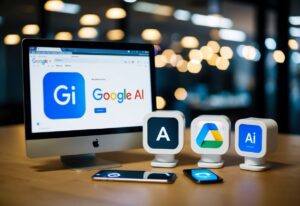Everything About AI: Comprehensive Insights and Future Trends
Do you want to know everything about AI? From its definition and history to applications, benefits, challenges, and future trends. Your complete guide to understanding artificial intelligence.
Artificial intelligence, often termed AI, is changing the world at an impressive pace.
It is a technology that enables machines to perform tasks that usually require human intelligence. These tasks range from recognizing speech to making complex decisions.

In recent years, AI has expanded into various fields. It’s found in everything from smart personal assistants to advanced data analysis tools.
By learning from data, AI systems can improve over time, making them highly efficient and dynamic. More and more, AI is being integrated into solutions that help people work smarter and faster.
AI also brings opportunities for collaboration between humans and machines. It enhances human capabilities and can handle repetitive tasks, allowing people to focus on creative and strategic work.
With evolving trends, the future of AI promises to bring even more innovation and challenges that need careful planning and regulation.
Key Takeaways
- AI performs tasks needing human intelligence.
- AI is integrated in many fields, improving efficiency.
- AI facilitates human-machine collaboration.
Foundations of Artificial Intelligence
The foundations of AI trace back to early theories and experiments, evolving through significant milestones and theories that have shaped the field today.
Everything about AI: History and Evolution
The history of artificial intelligence began in the mid-20th century. Alan Turing, a pivotal figure, introduced the idea of machines that could think. His concept of the Turing Test challenged the notion of human-like intelligence in machines.
In 1956, the term “artificial intelligence” was coined by John McCarthy during the Dartmouth Conference, marking the formal beginning of AI as a field. This period saw the creation of the first AI programs like Logic Theorist, which demonstrated machines’ potential to solve complex problems.
As computing power increased, AI’s capabilities also grew. These developments led to areas such as machine learning and deep learning. These advancements broadened AI’s applications in various industries.
Key Concepts and Terminology
Understanding AI requires familiarization with several core concepts.
Machine learning is a subset of AI, focusing on systems that can learn from data patterns. Meanwhile, deep learning further refines this process through neural networks, enabling more complex insights.
Natural language processing (NLP) allows machines to interpret and respond to human language, playing a critical role in applications like chatbots and virtual assistants.
Robotics, on the other hand, integrates AI to automate and enhance physical tasks performed by machines.
Key terms like algorithm—the set of rules a machine follows to solve problems—and data mining, which involves discovering patterns in large datasets, are integral to how AI works and advances its applications.
Major Milestones
The journey of AI is punctuated by notable milestones that have shaped its progression.
In the 1960s, the first chatbot, ELIZA, showcased early NLP capabilities. The publication of Artificial Intelligence: A Modern Approach by Stuart Russell and Peter Norvig provided a comprehensive overview of AI practices and theories.
In 1997, IBM’s Deep Blue defeated chess champion Garry Kasparov, demonstrating AI’s problem-solving prowess.
The arrival of self-driving AI-powered cars and AI in healthcare has revolutionized how these sectors operate, showcasing AI’s adaptive nature and its broad impact on society.
Everything about AI Technologies and Methodologies
AI involves various technologies and methods to allow machines to mimic human intelligence. Key areas include machine learning, neural networks, deep learning, natural language processing, and computer vision.
These technologies enable computers to learn, adapt, and interpret data in ways that were once purely human tasks.
Machine Learning
Machine learning uses algorithms to enable computers to learn from data. It includes techniques like supervised learning, where models are trained on labeled data, and unsupervised learning, which discovers patterns in unlabeled data.
Reinforcement learning is another approach, focusing on training models through rewards and penalties.
Machine learning powers many applications. For example, it drives recommendation systems in platforms like Netflix and provides predictive analytics in various industries. As a foundational technology, it lays the groundwork for more complex AI systems.
Deep Learning
Deep learning is a subset of machine learning involving neural networks with multiple layers. These networks can learn complex patterns and representations in data.
Convolutional neural networks (CNNs) are a popular architecture in deep learning, especially for image processing tasks.
Deep learning enables capabilities like facial recognition and has enhanced AI’s ability to analyze vast amounts of data. It is integral in applications requiring the understanding of intricate data structures and relationships, such as in generative AI and advanced speech recognition.
Neural Networks and ANNs
Neural networks are inspired by the human brain. They consist of interconnected nodes or “neurons” organized in layers.
Artificial Neural Networks (ANNs) help solve problems without explicitly programmed rules. They adapt to new data, enhancing machine intelligence.
One of the most important types is the recurrent neural network (RNN), used in sequence prediction tasks. These are vital in applications such as time series forecasting, handwriting recognition, and predictive text input.
Natural Language Processing
Natural Language Processing (NLP) enables computers to understand and interact using human language.
It comprises tasks like text translation, sentiment analysis, and chatbot development. NLP relies heavily on machine learning techniques to improve its functionality.
NLP applications include virtual assistants like Siri and chatbots on customer service websites. It plays a crucial role in making AI interactions feel more natural and intuitive, allowing for smoother communication between humans and machines.
Computer Vision
Computer vision allows machines to interpret and process visual information. It uses both machine learning and deep learning techniques to identify and understand images and videos.
Key applications include object detection, facial recognition, and autonomous vehicles.
Convolutional neural networks are a significant part of computer vision. These networks help machines recognize patterns in images, vital for tasks such as medical image analysis and real-time video processing in surveillance systems.
AI Applications
AI technology is making significant strides across various sectors. This evolution influences industry automation, healthcare advancements, consumer product enhancements, and safety measures.
Industry and Automation
AI is revolutionising the industrial sector through automation. Companies are increasingly using AI to streamline production processes, which improves efficiency and reduces costs.
Robots and AI systems are now common in manufacturing, where they handle repetitive tasks with precision and speed.
Self-driving cars represent a leap in automation, combining AI with advanced sensors to navigate roads. This innovation is reshaping transportation and logistics.
AI-driven systems are also adept at predicting equipment failures, thereby minimizing downtime and enhancing productivity.
Healthcare and Medical Research
In healthcare, AI applications are offering new possibilities for diagnosis and treatment.
Machine learning algorithms analyze complex medical data, helping identify potential health issues faster and with greater accuracy.
AI aids medical research by uncovering patterns in large datasets, accelerating drug discovery, and optimizing clinical trials.
AI is vital for personalizing patient care. It helps develop treatment plans tailored to individual needs. Using AI, medical imaging becomes more accurate, assisting doctors in detecting diseases at earlier stages.
Consumer Products
AI is deeply integrated into consumer products, enhancing everyday life.
Voice assistants like Alexa, Siri, and Google Assistant use AI to understand and execute spoken commands, providing a hands-free way to manage tasks.
In smartphones, facial recognition and Face ID add layers of security while simplifying access.
AI offers customization, learning user preferences to suggest content. This personalization touches facets of consumer experience, from streaming services to online shopping. It continuously adapts, providing recommendations that align with user interests.
Safety and Surveillance
AI plays a critical role in enhancing safety and surveillance.
Facial recognition systems can identify individuals in crowds, providing security at events and public spaces. This technology, while advanced, raises ethical concerns regarding privacy.
In fraud detection, AI enhances security by analyzing spending patterns to detect anomalies. This analysis happens in real-time, allowing quick response to potential threats.
AI-driven cameras and systems help monitor and secure infrastructure, supporting law enforcement and private security efforts.
Everythng about AI continues
AI and Human Interaction
AI is transforming many aspects of human life, from enhancing abilities to ethical considerations.
It plays a role in decision-making and helps improve quality of life. These changes are shaping how humans and AI interact in meaningful ways.
AI Enhancing Human Capabilities
AI technologies have made it possible for humans to perform tasks beyond their natural capabilities.
For instance, AI systems can process large datasets swiftly, providing insights that assist humans in making informed decisions. This ability is often seen in fields like healthcare, where AI aids in diagnosing diseases by analyzing medical images with great accuracy.
AI also contributes to fields such as education, where it can customize learning experiences based on individual needs.
By predicting learning paths, AI helps tailor instruction to suit each student. In manufacturing, AI-powered robots enhance productivity and precision, reducing human error and increasing efficiency.
Ethics and AI
The use of AI systems raises important ethical questions.
One of the crucial topics involves bias in AI, which can lead to unfair outcomes.
Algorithms trained on incomplete or biased datasets may inadvertently reinforce existing prejudices.
Recognizing and mitigating these biases is essential to ensure fairness and equality.
AI ethics also encompasses issues of privacy and consent. In contexts where AI collects personal data, safeguarding this information is critical for user trust.
Additionally, AI accountability is a concern, as determining who is responsible for AI-driven decisions can be challenging.
Ensuring AI safety is another ethical consideration, as AI systems must be reliable and free from vulnerabilities that could harm users. Addressing these ethical concerns is vital for fostering responsible AI development.
AI in Decision-Making
AI systems are increasingly used to enhance decision-making processes.
They can analyze complex data to provide recommendations, helping businesses make strategic choices based on solid evidence.
In finance, AI algorithms predict market trends, enabling investors to make better-informed decisions.
Despite their advantages, AI-driven decisions require careful consideration. The context in which AI operates can greatly affect outcomes.
Human oversight remains essential to ensure that AI recommendations align with ethical and societal values. This reduces the risk of automated systems making impactful decisions without understanding the full human implications.
AI Assistance and Improvement of Life Quality
AI plays a significant role in enhancing the quality of life by providing personalized assistance.
Virtual assistants, such as smart speakers, offer convenience by organizing schedules, controlling smart home devices, and providing information on demand.
In healthcare, AI-enabled wearables monitor vital signs and provide alerts for potential health issues, fostering better management of chronic conditions.
AI-driven applications in transport, like route optimization, improve commuting experiences by reducing travel time and improving safety.
AI’s capacity to anticipate needs and offer timely solutions helps simplify daily life and enhances overall well-being.
By offering tailored support, AI technologies improve individual experiences, demonstrating their potential to enrich human life in various areas.
The Impact of AI
Artificial intelligence (AI) is changing many areas of life. It has far-reaching effects, from reshaping markets and industries to transforming educational practices and sparking debates about its role and influence.
AI in the Global Economy
AI plays a key role in the global economy.
It drives innovations in marketing and business operations by automating tasks and improving decision-making.
Businesses can analyze data to tailor marketing strategies more effectively, targeting specific customer groups with personalized messages.
Moreover, AI influences employment as new jobs are created while others may become obsolete.
Industries like manufacturing and finance use AI for efficiency, but concerns about job displacement and the need for workforce reskilling remain prevalent.
Policymakers and business leaders must consider these impacts as they shape economic strategies.
AI in Education
In education, AI offers personalized learning experiences.
It helps identify students’ strengths and weaknesses, providing tailored support and resources.
AI tutoring systems and learning apps are gaining popularity, enabling students to learn at their own pace.
Teachers can use AI tools to manage administrative tasks efficiently, allowing more time for teaching.
While AI enhances the learning environment by promoting engagement and understanding, it also raises questions about data privacy and the role of teachers in a tech-driven educational landscape.
As AI continues to advance, balancing technological benefits with ethical considerations is essential.
The AI Debate and Public Perception
The advancement of AI sparks debates about its role in society.
Some view it as a transformative tool for innovation and progress, while others express concerns over job loss, privacy issues, and misinformation.
AI systems, if not managed carefully, can perpetuate biases and spread false information.
Public perception varies. Supporters emphasize AI’s potential to solve complex problems, while skeptics worry about ethical implications and the unchecked power of AI companies.
Addressing these debates involves continuous AI research, policy development, and open communication to ensure that AI technology benefits society while minimizing risks.
AI Types and Levels of Autonomy
Artificial Intelligence (AI) can be categorized by its types and its level of autonomy. From narrow AI to superintelligence, each type has unique capabilities and potential.
The autonomy of AI spans from performing specific tasks to surpassing human intelligence in all areas.
Narrow AI vs. General AI
Artificial Narrow Intelligence (ANI), also known as narrow AI, is designed for executing specific tasks.
This type of AI excels in areas like language translation and facial recognition. It does not possess the ability to perform beyond its programmed function. Examples include Apple’s Siri and Amazon’s Alexa.
Artificial General Intelligence (AGI), or general AI, aims to perform any intellectual task that a human can do.
While AGI remains theoretical, it represents the goal for machines to think, learn, and understand on a human level.
This would enable them to solve a variety of tasks without human intervention.
The development of AGI will require significant advancements in knowledge and technology.
Superintelligence refers to a level where machines surpass human intelligence.
This is not yet achieved but holds transformative potential for science and technology. Discussions around superintelligence often focus on long-term impacts and ethical considerations.
Superintelligence Potential
Superintelligence could revolutionize numerous fields, from healthcare to space exploration, due to its superior problem-solving skills.
If attained, it would outpace human cognitive capabilities and provide solutions to complex problems far quicker than humans.
Potential benefits also include significant advancements in technology and innovation.
However, experts debate the risks of machines acting beyond human control. The ethical implications remain a significant concern, with issues related to safety and governance taking center stage.
It is crucial to explore not only the possibilities of superintelligence but also the frameworks needed to maintain safety and benefit society.
AI Systems and Infrastructure
Everything about AI systems require robust infrastructure composed of hardware and software. This infrastructure enables efficient processing and deployment of various AI technologies.
Compute and Cloud Computing
The foundation of AI applications lies in compute capabilities, which involve using powerful processors like GPUs and TPUs.
These processors are vital for running complex algorithms quickly and efficiently.
Cloud computing enhances this by providing scalable resources whenever needed, allowing AI systems to process large datasets without needing onsite hardware.
Organizations often rely on cloud providers like AWS, Google Cloud, and Azure.
These platforms offer tools and resources tailored for AI, ensuring seamless integration and scalability. The combination of advanced hardware and cloud services plays a crucial role in the growth and success of AI initiatives.
Large Language Models and GANs
Large language models (LLMs) like GPT and BERT have revolutionized natural language processing.
They can generate text, answer questions, and perform translation tasks with impressive accuracy.
Generative adversarial networks (GANs) are another breakthrough, used for creating realistic images and videos.
This technology is behind many image generators and even some deepfakes.
While LLMs handle text, GANs excel at mimicking visual content. Both AI technologies require significant computational power, making the infrastructure supporting them essential.
AI Alignment and Explainability
Ensuring AI aligns with human values and ethical guidelines is crucial.
AI alignment aims to create systems that operate in beneficial ways without unintended consequences.
To achieve this, understanding how AI makes decisions is vital, which is where explainability becomes important.
Many AI models operate as black boxes, meaning their decision-making processes are not easily understood.
Efforts in explainability focus on making AI’s reasoning more transparent. This is essential to build trust in AI systems, ensuring they act predictably and in accordance with user intentions.
Emerging Trends and the Future of AI
Artificial intelligence continues to grow and reshape various industries through innovations and research. These developments point to an exciting future with new capabilities in creativity and problem-solving.
Recent AI Innovations
Recent advances in AI have brought significant changes in multiple fields.
Technologies like generative AI are now enabling creative tasks, such as content generation and digital artwork creation through platforms like Midjourney.
Developments in AI have also enhanced medical diagnosis systems, providing more accurate and faster results.
AI excels at tasks like playing chess, which showcases its ability to learn through trial and error to improve over time.
Innovations in smaller language models are also making AI more accessible and adaptable to specific needs, optimizing models for better performance.
Future Predictions and Expectations
The future of AI is filled with exciting possibilities.
Many experts anticipate that artificial intelligence will continue to advance technological trends, such as increased automation and smart devices.
Personalized solutions, based on patterns of individual behavior, are becoming more prevalent.
Artificial General Intelligence (AGI) remains a long-term goal, with researchers predicting decades before its realization.
In the near future, AI may unlock new creative potentials and problem-solving methods in everyday life, allowing it to tackle complex tasks with greater ease.
The AI boom is expected to expand, impacting everything from entertainment to engineering.
AI and Ongoing Research
Ongoing research is foundational to AI’s progression.
Leading organizations like Google AI continue to push the boundaries of what AI can do.
Research in multimodal AI is exploring how AI systems can process and understand various types of data better.
Focus areas include improving data pipelines and creating custom models for local application, allowing for more efficient solutions.
AI trends indicate that AI is set to become more sustainable and cost-effective.
Through continuous research and development, AI is expected to overcome current limitations and introduce new capabilities, ensuring it remains a cornerstone of innovation.
Data and AI
Data is a crucial element in artificial intelligence, acting as the fuel that powers AI systems. By leveraging vast amounts of information, AI can learn, adapt, and make decisions.
Structured datasets, big data, and advanced analytics enable AI to offer innovative solutions across various fields.
The Role of Data in AI
Data plays a vital role in the development and functioning of AI.
AI systems learn by processing data, which helps them recognize patterns and make predictions.
These systems require large amounts of quality data to perform effectively. Poor data can lead to inaccurate results, making data quality and preprocessing essential.
Collecting and cleaning data ensures that AI models can accurately process information and generate meaningful insights.
Using historical and real-time data, AI models can be trained to improve over time. Feedback loops help systems to self-correct and fine-tune their predictions.
Organizations utilize structured and unstructured data for diverse applications, from customer service to medical diagnostics.
The scope of data used impacts the accuracy and reliability of AI, emphasizing the necessity of high-quality datasets for robust AI development.
Big Data and Analytics
Big data refers to the massive volumes of data generated daily from various sources like social media, sensors, and transactions.
This data is characterized by its high velocity, volume, and variety.
By combining big data with advanced analytics, organizations can extract valuable insights, identify trends, and enhance decision-making processes.
Analytics tools process and analyze big data, making it manageable and insightful.
AI utilizes these analytics to turn raw data into predictive models and actionable strategies.
Companies invest in big data technologies to harness the potential of AI, leading to improved efficiency and innovative solutions in sectors like retail, healthcare, and finance.
Tools such as Hadoop and Apache Spark help manage and process vast amounts of data quickly.
Datasets and Data Science
Datasets serve as the foundation for training and testing AI systems. They include structured data like tables and unstructured data like text and images.
Good datasets are essential for developing effective AI models. Data scientists play a key role in preparing these datasets by cleansing and curating the data to ensure accuracy.
Data science integrates statistics, programming, and domain expertise to interpret complex datasets.
It involves the use of machine learning algorithms to create models that predict outcomes and discover patterns.
By employing techniques like data mining and visualization, data scientists convert data into actionable insights.
Collaboration between data engineers and scientists enables organizations to create reliable AI systems, leading to smarter technology solutions.
AI Legislation and Governance
AI legislation and governance are crucial to ensuring that the development and deployment of AI technologies are ethical and secure. Various regions have different approaches, including international regulations and specific acts like the Artificial Intelligence Act.
International Regulations
International regulations on AI aim to create a standard approach for managing this technology across borders.
Organizations like the United Nations and European Union are actively working on frameworks that address global challenges. These regulations focus on AI ethics, privacy, and security.
Lists can be useful to highlight essential points:
- Encourage transparency in AI design and application.
- Protect personal data and uphold privacy.
- Foster cooperation between nations for shared guidelines.
Such global efforts encourage cooperation between countries and ensure that AI technologies remain beneficial for all.
Artificial Intelligence Act
The Artificial Intelligence Act is a significant step for the EU. It sets a comprehensive legal framework to regulate AI.
This act categorizes AI systems according to risk levels: unacceptable, high, limited, and minimal.
- High-risk AI systems must adhere to strict rules. These rules ensure data quality and transparency.
- There is also a focus on keeping human oversight alive. This is to avoid complete dependence on automated systems.
By laying down these measures, the EU’s act aligns AI development with ethical norms. It also ensures organizations comply with stringent safety standards. This pivotal legislation demonstrates a strong commitment to balancing innovation with responsibility.
AI Collaborations
AI collaborations across various sectors and institutions are pivotal in driving innovation and breakthroughs. By partnering with diverse entities, AI development accelerates. It benefits from a wide array of expertise and resources.
Cross-Industry Partnerships
Cross-industry partnerships enable companies to combine their strengths for mutual benefit. By joining forces, businesses can harness AI to enhance product offerings, improve services, and streamline operations.
In particular, sectors like healthcare and finance use AI to improve diagnostics and automate financial analysis.
Such collaborations also foster innovation. For example, tech firms partner with automotive companies to develop smarter vehicles. These partnerships lead to advancements in autonomous driving and enhanced safety features.
By working together, industries can push the boundaries of what AI can achieve. They also bring transformative technologies to market faster.
Academic and Technological Alliances
Academic and technological alliances are crucial for advancing AI research. Universities and tech companies often join forces to conduct research that aims to solve complex problems.
These alliances allow academic researchers to access cutting-edge technology and vast datasets provided by industry partners.
Such collaborations contribute to breakthroughs in areas like machine learning and natural language processing. For instance, partnerships between universities and AI companies often result in the development of new algorithms and AI models.
These joint efforts not only advance academic knowledge but also lead to practical applications that benefit a wide range of industries. By pooling resources and expertise, these alliances significantly propel the field of AI forward.
Conversational AI
Conversational AI allows machines to understand and respond in natural language, making interactions more human-like. This technology powers tools like chatbots and virtual assistants, which streamline user communication and solve various tasks efficiently. Recent advancements have made these interfaces smarter, allowing them to handle more complex queries.
Chatbots and Virtual Assistants
Chatbots and virtual assistants are widely used applications of conversational AI. These tools can be found on websites and apps, helping users with inquiries and tasks.
They use machine learning and natural language processing to mimic human conversations. For instance, ChatGPT can generate coherent responses based on user input, enhancing user experience.
Virtual assistants like Alexa and Siri are another example. They perform tasks such as setting reminders or playing music using voice commands.
These tools not only save time but also reduce the need for human support, making them essential in today’s digital landscape.
Advancements in Conversational Interfaces
Advancements in conversational interfaces have transformed how AI interacts with users. Deep learning and natural language processing have significantly improved accuracy.
According to IBM’s overview of this technology, these innovations enable AI to better understand context, allowing more nuanced conversations.
This progress has led to more personalized user experiences. AI can now remember user preferences and history, making interactions smoother.
Companies are investing in these technologies to enhance customer service and engagement. These interfaces continue to evolve, promising even greater capabilities and efficiencies in various sectors.
Frequently Asked Questions
Artificial intelligence (AI) covers a wide range of topics, from its types and pioneers to practical examples in daily life. It includes foundational concepts and keeps evolving with new developments.
What are the different types of artificial intelligence?
Artificial intelligence can be divided into several types. The main categories are narrow AI, which is designed for specific tasks, and general AI that aims to understand or learn any intellectual task a human can do. Another category is super intelligent AI, which surpasses human intelligence.
Who is considered the father of artificial intelligence?
John McCarthy is often regarded as the father of artificial intelligence. He coined the term “artificial intelligence” in 1956 and was a significant figure in the development of AI as a field of study and research.
Could you provide a simple explanation of artificial intelligence?
Artificial intelligence involves creating machines that can solve problems, make decisions, and even learn from experience. These machines use algorithms and data to mimic tasks usually requiring human intelligence, like understanding language or recognizing patterns.
What are some common examples of artificial intelligence in use today?
Many everyday technologies use AI. Digital assistants like Siri and Alexa rely on AI to understand and respond to questions. Search engines like Google use AI for better search results. Self-driving cars and recommendation systems on platforms like Netflix are other examples.
What are the foundational concepts one should understand about AI?
Key concepts in AI include machine learning, which allows systems to learn from data. There is also deep learning, a subset of machine learning using neural networks. Lastly, natural language processing enables interactions between computers and humans using language. Deep learning is especially notable for its use in pattern recognition.
What are the latest developments in artificial intelligence for students to be aware of?
AI is continuously evolving. Advances include reinforcement learning, improved natural language processing, and AI ethics.
Schools now explore integrating AI education within curriculums to prepare students for a future where AI plays a significant role. Platforms like Fast.AI offer courses that help learners understand groundbreaking AI technologies.



















